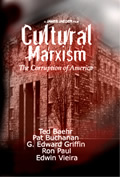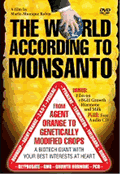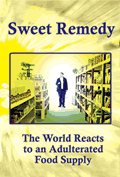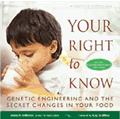STEPPING OVER STRAY DOGS
by
Scott Tips, JD
November 15, 2010
NewsWithViews.com
But watch out for the Codex mess
Santiago de Chile can be a beautiful place, but one of the first things a visitor notices is that it is a city of stray dogs. They are everywhere. No one abuses them. I’ve never seen that happen even once during my two, week-long visits here. But, then, I’ve never seen anyone feed them either. Some are plumpish, but most are lean and hungry. And too many have visible ribcages pushing out against fur.


So, although my main purpose here in Chile has been to attend the 32nd session of the Codex Committee on Nutrition and Foods for Special Dietary Uses (CCNFSDU), being held at the Crowne Plaza Hotel in the Santiago downtown area, I find myself saving the extra food from my meals and standing in line at supermarkets to buy pouches and tins of dog food to feed to the stray dogs outside of the Codex meeting hours. I am not trying to pat myself on the back, because it’s what any of us would – should – do; but while observing how invisible these strays are to the Chileans as they go about their daily lives, even when they see me feeding them, it has struck me as something of a curious parallel world to what has been taking place at the Codex meeting.
The Meetings
As you will recall, at last year’s CCNFSDU meeting in Germany, the National Health Federation (with help from the Indian and Iraqi delegations) was able to stop the advance of those Guidelines on Nutrient Reference Values (NRVs) [1] that would have set low numerical values for vitamins and minerals. Some delegations, especially Australia, were strongly pushing for these “dumbed down” NRVs to go forward. Had they gone forward at that time – as they very nearly did – then we would now be looking at well-advanced Codex NRVs of, for example, 45 milligrams for Vitamin C and 200 IUs for Vitamin D as providing 100% of an adult’s daily nutritional needs.[2]
This week of November 1-5, 2010, the CCNFSDU met once again to debate this and other NRV texts. Some 250 delegates from 80 countries were in attendance, comprised of country functionaries and international non-governmental organizations (INGOs) representatives. For the first time since I have been at these Codex meetings, Dr. Rolf Grossklaus was absent, his place as the CCNFSDU Chairman having been taken by Dr. Pia Noble, a woman with considerable Codex experience.
The Committee covered other topics too, such as draft guidelines on the addition of essential nutrients to foods and formulated supplementary foods for older infants and children. The latter was a hotly-debated topic. But for me, the NRV issue was the critical one, especially given the victory at the meeting last year. Could we repeat our success? I had thought this year’s fight would be a long, drawn-out one in the full session of the Committee, and had even prepared and submitted extensive written comments to the Committee.[3] Instead, in just one afternoon, at the special Saturday (October 30th) meeting of the CCNFSDU Working Group on NRVs, we were able yet again to keep the dumbed-down NRVs from advancing even one step. Here’s what happened.
The Saturday Fight
The Australian delegate chaired the Working Group’s Saturday afternoon session on NRVs and did her usual, admirable job of allowing all viewpoints to be heard. A very-decent person whom I have known for many years now, the Australian delegate nonetheless has a heavily-vested interest in pushing forward the dumbed-down NRVs. She has that bureaucratic risk-assessor’s mindset that vitamins and minerals are dangerous. But more than that, she personally crunched the numbers and gave birth to them. These are her babies.
So it could be no surprise to anyone that the afternoon’s meeting opened with a strong push for the Working Group to recommend that these NRVs go forward as “recommended” to the full Committee on Monday. Of the delegates, the European Union (EU) was the first to speak out and opposed the figures as having been based on old data. The NHF spoke up next and agreed with the EU position, arguing the points made in the NHF’s written comments.
The Chairwoman tried to defend the numbers, while the United States delegate pushed for a review of just a few of the vitamins (Vitamins A, C, and D, and perhaps potassium). IADSA (the International Alliance of Dietary Food Supplement Associations) supported the US proposal, while many others opposed it, calling for a full review. As the NHF delegate, I argued once again for a full review stating that where some values are wrong, then all are suspect and should be revisited. Encouraged, China asked for a higher NRV for selenium. The Australian chairwoman attempted to get China to back down by alleging that countries would still have the right to set their own values. “Do you wish to continue with your request?” she then asked China. In the past, China would have backed down. But not this time. “Yes,” China flatly replied.
Facing increasing opposition, the Chairwoman decided that saving some of her babies was better than losing them all and issued a fiat decision to the Working Group that Vitamins A, C, and D would be referred back to the Food and Agriculture Organization (FAO) and World Health Organization (WHO) for further review, while the remaining NRVs would be accepted as is.
I immediately objected, as did in turn other delegations such as Thailand, China, Mexico, South Africa, Malaysia, and Zimbabwe. The US delegate asked the very-sensible question, “Do we need to look at other authoritative scientific data [and not just that of FAO/WHO]?”
In the end, accepting the inevitable, the Working Group Chairwoman reversed her position and announced that the Working Group would report to the full session of the Committee on Monday its position that all NRVs and their data were to be re-reviewed by FAO/WHO. And with that, the Saturday meeting ended.
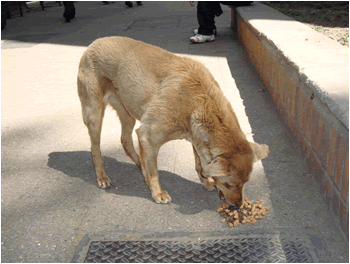
Another satisfied Chilean
consumer
Heresy at Codex
The regular session of the CCNSFDU opened two days later, and first addressed various other topics before getting down to the business of debating the NRV guidelines and the NRVs themselves. After successfully turning the Committee around to accepting Preamble wording in the Guidelines that broadened the factors a country could use in setting its own NRVs, the NHF was unfortunately unsuccessful in altering the ambiguous wording of Upper Level of Intake of Nutrients (defined as “the maximum level of habitual intake from all sources of a nutrient or related substance judged to be unlikely to lead to adverse health effects in humans”). CCNFSDU Chairwoman Pia Noble said this definition could not be changed since it was taken directly from the Nutritional Guidelines.
In discussing what scientific authority would be the primary source, the delegates largely expressed their continued faith in the FAO and WHO. Some, including NHF, wanted to broaden the scope of the scientific authorities that Codex would use in setting its NRVs. Yet, the near-religious adoration of the FAO/WHO scientific consultations prevailed.
When the Chairwoman finally recognized NHF to speak on the subject of whether or not non-FAO/WHO scientific sources could be considered, I was blunt, “Are we really saying here that there is never an instance where FAO/WHO science is less valid than others at some time? Are we saying that the FAO and WHO are infallible, that they never make mistakes. As NHF has said several times in the past, FAO/WHO put their pants on one leg at a time just like everyone else. We need to go back to the original wording of that language that allowed for other recognized scientific sources to be used even over FAO/WHO. For if other science exists that is better, why shouldn’t it be used even if it is not from FAO/WHO? At the Working Group meeting last Saturday, it was recognized by many of the delegations that in setting the NRVs, the FAO/WHO data is very outdated. So, again, if better science exists, then why not use it? It’s an open secret anyway that the FAO/WHO consultation results are suspect because the experts are cherry-picked and the end results pre-determined. [murmurs of dissent directed to NHF at this point] You may not like what I have to say, but outside this room, the feelings about that science are very different. Many may genuflect at the altar of the FAO/WHO, but why limit yourself when the possibility of better science exists?”
The Committee then took a coffee break. But evidently the effect of my comments was so strong that the WHO representative at the podium felt the need to spend five minutes after the break telling the delegates that I had “mischaracterized” its science and then outlining the steps WHO took to ensure valid scientific results. Not surprisingly, the outlined steps were no refutation whatsoever of what I had said because those steps could still be easily tweaked to obtain biased experts and biased results. I was pleasantly surprised, though, to have some delegates approach me privately afterwards and express their agreement with my comments. As a parting note, on the final day of the meeting, the Chairwoman improperly refused my request to have my comments entered into the CCNFSDU official Report of the meeting. So much for Codex transparency.
NRVs are Thrown Back in the Oven for Reheating
The second day of the Committee’s meeting saw a continuation of its discussion of the NRV Guidelines and NRVs. By this point, the Chairwoman was terribly gun-shy about recognizing NHF to speak. Several times, she refused to do so. Other times, I had to wait for up to 30 minutes after having pushed my call button to be recognized to speak. The former Chairman, Dr. Rolf Grossklaus, started looking pretty good to me in retrospect.
The discussion turned to the actual nutrient reference values for vitamins and minerals, and the US delegate renewed her push for the FAO/WHO to only consider the “more important” of those nutrients. A brief rehash of Saturday’s debate was held, but the Chairwoman came down squarely in favor of the Working Group’s decision to refer all of the vitamin-and-mineral NRVs back to the FAO and WHO for reconsideration.
The NHF spoke up supporting the Chairwoman’s position, and then took the opportunity to challenge the “Physiological Endpoints” used by the FAO/WHO to calculate the “dumbed down” NRVs. One example I gave was the inanity of deciding upon using the halfway point between tissue saturation by Vitamin C and clinical signs of scurvy as the level (45 mg) at which the Vitamin-C values would be set! So, halfway between health and death was to be an acceptable NRV level? Why not simply choose the healthy level? Unfortunately, this is the kind of mindset that usually prevails at Codex.
But not this time. The Committee agreed to refer all of the NRVs back to FAO and WHO for re-review. Of course, it would have been much better to have had the data redone by real clinical scientists and researchers and not just risk assessors. Still, the NRVs were once again held back, so we can be thankful for that much.
| Subscribe to the NewsWithViews Daily News Alerts! |
We Are the Stray Dogs
As consumers the World over hunger for real nutrition, they are still treated as nothing more than objects to be stepped over. The “experts” think they know better, yet they know nothing. These regulators, posing as defenders of nutritional virtue, are instead pushing for the very guidelines that destroy health. Fixated as they are on assessing false risks associated with vitamins and minerals, they blind themselves to the benefits these nutrients confer. It is a world they do not understand. Even worse, they blindly step over those who need real nutrition. We are nothing but stray dogs to them.
Footnotes:
1-
Not to be confused with Maximum Upper Permitted Limits, NRVs are nothing
more than souped-up RDAs. These are numerical values assigned to specified
nutrients that supposedly reflect the “typical” person’s
nutritional needs for that nutrient. By referring to the NRV for a vitamin
or mineral, the consumer is supposed to know whether he or she is getting
an adequate intake of that nutrient, even if, as in the case of Vitamin
C, 100% of the NRV is defined as 45 milligrams! These values are claimed
to be set according to rigorous scientific evidence; but, in reality,
“science” at Codex levels is often nothing more than a flimsy
set of assumptions and erroneous conclusions cobbled together to justify
keeping consumers “safe” from “dangerous” vitamins
and minerals.
2-
The proposed Codex NRVs are: Vitamin A (dropped from 800 mcg to 550
mcg); Vitamin D (5 mcg or 200 IUs); Vitamin E (8.8 mg); Vitamin K (60
mcg); Vitamin C (dropped from 60 mg to 45 mg); Thiamin (dropped from
1.4 to 1.2 mg); Riboflavin (dropped from 1.6 mg to 1.2 mg); Niacin (dropped
from 18 mg to 15 mg); Vitamin B6 (dropped from 2 mg to 1.3 mg); Folate
(raised to 400 mcg); Vitamin B12 (2.4 mcg); Pantothenate (5 mg); Biotin
(30 mcg); Calcium (raised from 800 mg to 1000 mg); Magnesium (dropped
from 300 mg to 240 mg); Iodine (150 mcg); Iron (14.3-43.1 mg depending
upon bioavailability); Zinc (dropped from 15 mg to 3.6-11.9, depending
upon bioavailability); Selenium (30 mcg); Phosphorus (700 mg); Chloride
(2.3 grams); Copper (900 mcg); Fluoride (3.5 mg); Manganese (2.1 mg);
Chromium (30 mcg); and Molybdenum (45 mcg).
3-
See www.thenhf.com/article.php?id=2584.
� 2010 - Scott Tips - All Rights Reserved


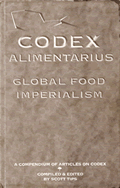









 Share
This Article
Share
This Article